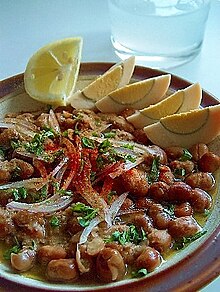Ful medames: Difference between revisions
No edit summary |
No edit summary |
||
| Line 1: | Line 1: | ||
[[Image:Ful.jpg|thumb|right|Ful Medames served with sliced [[Egg (food)|eggs]] and [[vegetables]].]] |
[[Image:Ful.jpg|thumb|right|Ful Medames served with sliced [[Egg (food)|eggs]] and [[vegetables]].]] |
||
'''Ful medames''' ([[Arabic]]: '''فول مدمس''') is one of the [[national dish]]es of [[Egypt]], often eaten at breakfast. It consists of [[Vicia faba|fava beans]] slow-cooked in a copper pot that have been partially or completely mashed. [[Olive oil]] is often an ingredient, and [[garlic]] is sometimes added. Ful medames is served with plenty of olive oil, chopped [[parsley]], [[onion]], garlic, and [[lemon]] juice, and typically eaten with Egyptian ('' |
'''Ful medames''' ([[Arabic]]: '''فول مدمس''') is one of the [[national dish]]es of [[Egypt]], often eaten at breakfast. It consists of [[Vicia faba|fava beans]] slow-cooked in a copper pot that have been partially or completely mashed. [[Olive oil]] is often an ingredient, and [[garlic]] is sometimes added. Ful medames is served with plenty of olive oil, chopped [[parsley]], [[onion]], garlic, and [[lemon]] juice, and typically eaten with Egyptian bread ('''eish masri''). Though originally a [[peasant food]], it has long been part of the daily Egyptians' diet. It is particularly renowned for being a very filling dish, with many describing it as being 'like a stone in the stomach'. This has led to it being consumed by many in the Middle East in the early morning meal to prepare for a day of fasting during [[Ramadan]]. |
||
{{Hiero | Ful | <hiero>p:V1-y:r-Z1-N33:Z2</hiero> | align=left| era=default}} |
{{Hiero | Ful | <hiero>p:V1-y:r-Z1-N33:Z2</hiero> | align=left| era=default}} |
||
The dish's name derives from the [[Egyptian language]]: ''ful'' is derived from the Egyptian word for fava beans, and ''medames'' is a [[Coptic language|Coptic]] word meaning "buried." The second word hints at the original cooking method, which involved burying a sealed pot of water and beans under hot coals. This cooking method for fava beans is mentioned in the [[Jerusalem Talmud]], indicating that it has been used in the [[Middle East]] at least since the [[4th century]]. |
The dish's name derives from the [[Egyptian language]]: ''ful'' is derived from the Egyptian word for fava beans, and ''medames'' is a [[Coptic language|Coptic]] word meaning "buried." The second word hints at the original cooking method, which involved burying a sealed pot of water and beans under hot coals. This cooking method for fava beans is mentioned in the [[Jerusalem Talmud]], indicating that it has been used in the [[Middle East]] at least since the [[4th century]]. |
||
Revision as of 18:05, 15 March 2008

Ful medames (Arabic: فول مدمس) is one of the national dishes of Egypt, often eaten at breakfast. It consists of fava beans slow-cooked in a copper pot that have been partially or completely mashed. Olive oil is often an ingredient, and garlic is sometimes added. Ful medames is served with plenty of olive oil, chopped parsley, onion, garlic, and lemon juice, and typically eaten with Egyptian bread ('eish masri). Though originally a peasant food, it has long been part of the daily Egyptians' diet. It is particularly renowned for being a very filling dish, with many describing it as being 'like a stone in the stomach'. This has led to it being consumed by many in the Middle East in the early morning meal to prepare for a day of fasting during Ramadan.
| |||||
| Ful in hieroglyphs | |||||
|---|---|---|---|---|---|
The dish's name derives from the Egyptian language: ful is derived from the Egyptian word for fava beans, and medames is a Coptic word meaning "buried." The second word hints at the original cooking method, which involved burying a sealed pot of water and beans under hot coals. This cooking method for fava beans is mentioned in the Jerusalem Talmud, indicating that it has been used in the Middle East at least since the 4th century.
Ful medames worldwide
Ful medames was exported from Egypt to the Arab World (particularly, the Levant) and parts of East Africa (mainly in Somaliland and Somalia). Ful medames came to the Horn of Africa when the Egyptians captured Zeila in the beginning of the 19th century. From that city the ful extended across the region, spread by Somalis and Egyptians. In Somaliland, ful is eaten with a bread called laxoox, which is highly popular across the region. Ful is also eaten in Ethiopia, where it is served with flatbread and mitmita powder. The recipe also spread to parts of Europe, United States of America, Middle East and United Kingdom, brought by travelling Egyptians.
The combination of ful and hummus is popular in Israel[1], Syria and Lebanon. A typical hummus-ful dish consists of a layer of hummus topped with a serving of ful, accompanied by a quartered egg.
References
- ^ "Land of hummus and pita (a hummus glossary)". Ynetnews. Retrieved 2008-03-07.
